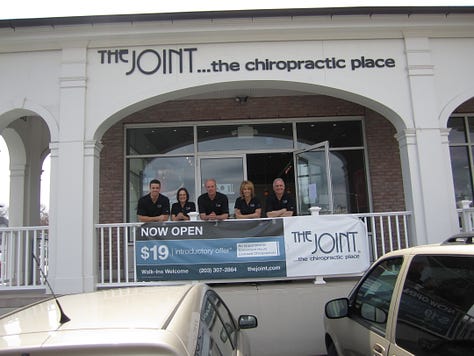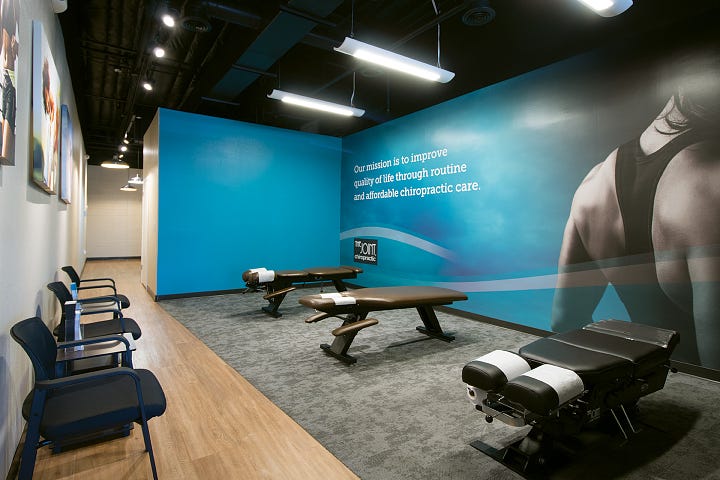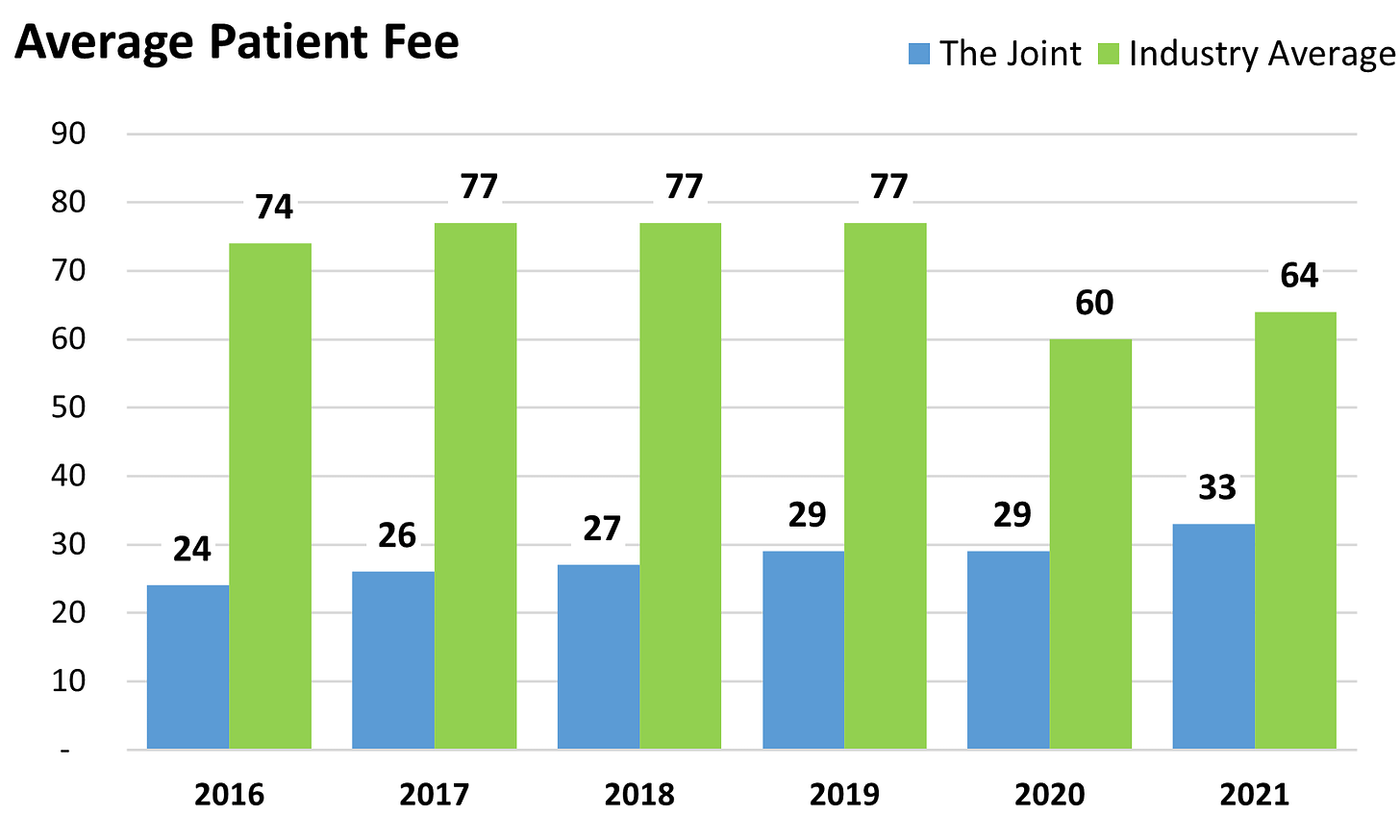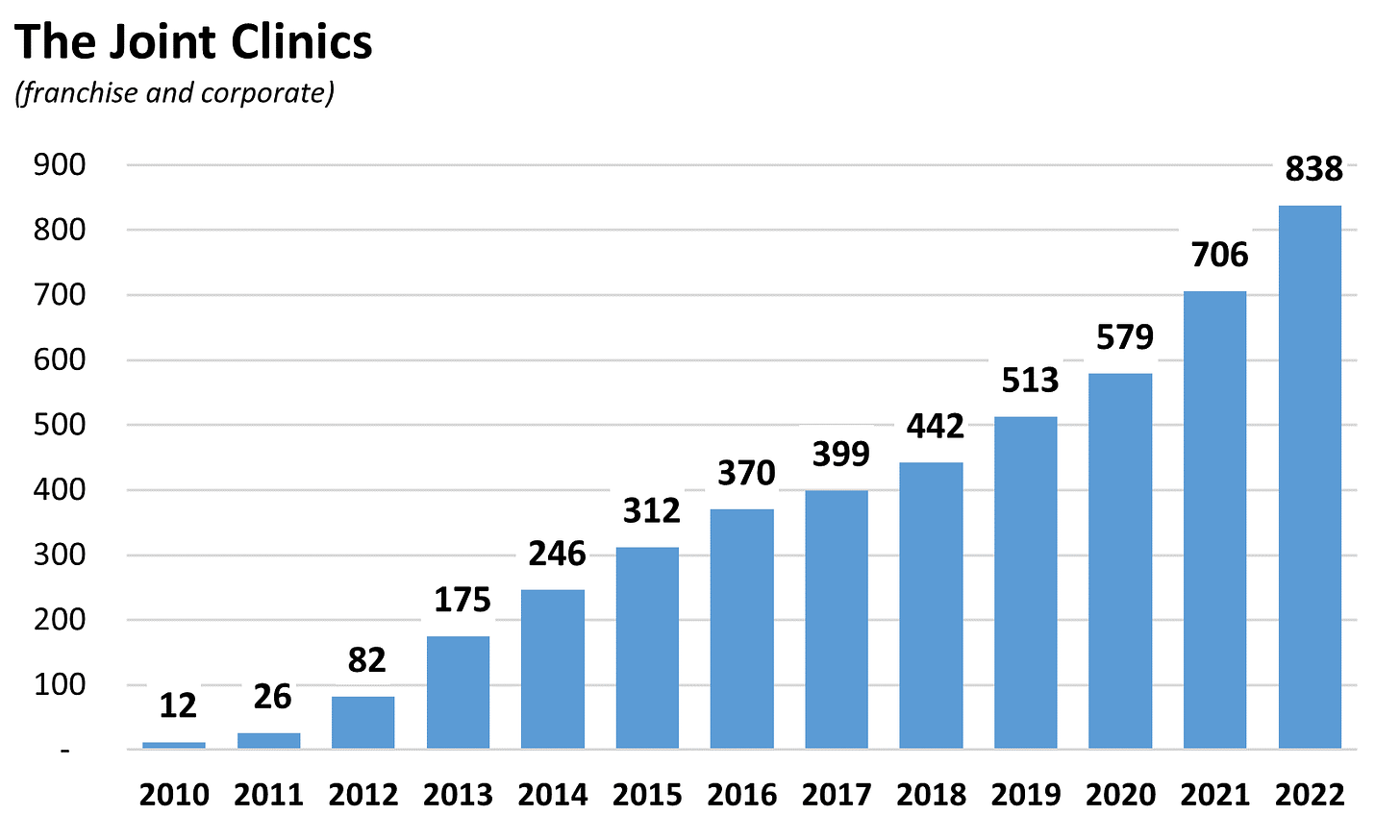A Look at The Joint
What is The Joint? What are the economics? How large is the opportunity? What prevents competitors from copying its strategy?
This article continues where my last article left off. I hope to explain why The Joint Corp is a compelling business.
What is The Joint Corp?
The Joint Corp is a franchisor (~85% of clinics) and operator (~15%) of a cash-pay (no insurance) retail chiropractic concept focused on convenience (walk-in only; located in popular strip malls) and affordability ($29 first visit, $89 monthly membership).





The concept’s playbook is relatively simple:
Open a small (~800—1,200 sq. ft.) clinic in a busy strip mall.
(Locate clinic within a regional cluster to maximize brand awareness.)
Offer affordable, convenient access to chiropractic care.
Follow a proven local and digital marketing strategy to attract patients.
Upsell the patient to a monthly membership after the first visit.
Retain the patient as long as possible.
With over 800 locations, the concept has proven to be simple and repeatable, with The Joint now among the top 2% of all franchisors by size. Its model suits chiropractic because adjustments are brief (5-7 minutes) — there’s no need for an appointment. For consumers, this is convenient; it’s easy to stop in as they often visit the strip mall during the week anyway. For clinics, it’s efficient; each doctor can handle more patients per day.
What are the economics?
From the Lens of a Franchisee
From a franchisee perspective, the total investment comes out to ~$300-350k (typically 1/3 cash, 2/3 financed by SBA or other lender):
$39,990 franchise license fee ($10k less for each additional)
~$200-250k clinic build-out (leasehold improvements, equipment purchases, security deposit, business licenses, recruiting, etc.)
~$76k Year 1 losses
This compares to Sport Clips at ~$300-400k, Massage Envy at ~$600-900k, and generally over $1 million for Planet Fitness.
After ~6-9 months, the average clinic breaks even, and the franchisee begins to recoup their investment with profits. After ~3.5 years, the franchisee is fully paid back, at which point they tend to be earning a 50% cash on cash return annually. The average clinic progresses as follows (after Year 1 losses):
Year 2: $78k EBITDA on $432k sales (~18% margin)
~25% cash-on-cash return for franchisee
Year 3: $141k EBITDA on $531k sales (~26% margin)
~45% cash-on-cash return
Year 4: $161k EBITDA on $565k sales (~28% margin)
~50% cash-on-cash return
Full investment recouped mid-way through year
These clinics also continue to grow after Year 4, leading to EBITDA margins of ~30% at maturity. And with no working capital and minimal maintenance capex (clinics get paid upfront and only need a few chiropractic tables, chairs, and computers), EBITDA can be a useful proxy for cash flow.
As franchisees often fund part of the initial investment with a loan, we can gauge the strength of the economics from a lender’s willingness to lend. Banks use a FUND score to assess default risk for a franchise concept, similar to a FICO score for individuals. The Joint recently announced its latest FUND score was 910 (out of 950) compared to the average of 593.
The Franchisor View
In addition to the one-time license fee (amortized over 10 years but received in cash), The Joint Corp charges a 7% royalty on gross clinic sales, a 2% national marketing fee, and a $599 monthly software fee.
The Joint does not sell most of its franchise licenses, however. Instead, it sells the right to open a minimum number of clinics in a defined territory to regional developers (RDs). RDs are then responsible for finding qualified franchisees and assisting them with site selection, recruitment, training, and support. In return, The Joint kicks back 3% (of its 7%) from clinics in RD territories and shares a portion (up to 50%) of every license fee.
RDs sacrifice some near-term economics but are essential to quickly build scale. RDs were responsible for over 80% of franchise license sales from 2019 to 2021 and 62% in the first nine months of 2022. Once a territory matures, however, the RD’s importance diminishes, at which point The Joint will re-acquire the territory to protect its longer-term economics.
Drivers of Clinic Unit Economics
The clinic cost structure is largely fixed (rent, salaries, insurance), so more patients translate into more profits. The key to profitability in The Joint’s structure, therefore, lies in maintaining high patient volumes.
The convenience factor is essential to high patient volumes. People don’t want to go out of their way for a chiropractor. But, if it’s located somewhere they tend to visit a few times each week anyway, they are more willing to try it — especially with no appointments and visits generally under 10 minutes.
Of course, people also value price.
The convenience and price duo attracts lots of new patients, nearly 60% of whom interact in some way with the company’s digital marketing campaigns.
And the ability to promote a specific, cash (no insurance) price provides an edge in marketing. People aren’t likely to try the chiropractor after seeing a generic promotion, but they might give it a try after seeing a $29 promotion. Regardless, marketing has proven to be a core strength of the business.
Further, its success extends to patients unfamiliar with chiropractic, implying The Joint is growing the pie, not just gaining share. In 2021, 36% of its new patients were new to chiropractic, 27% in 2020, and 26% in 2019 and 2018. In aggregate, that’s over 700,000 new patients to chiropractic in just four years.
Getting patients in the door, however, is half the battle. The next step requires the upsell to a monthly membership (85% of 2021 revenue). The method is simple:
Patient tries The Joint after seeing a $29 first visit promotion.
Has a good experience.
After, wellness coordinator upsells the patient to a monthly membership.
Instead of $45 per visit the second time around, a monthly membership is $89 for 4 visits (<$23 per visit). Conversion rates on the upsell are strong (50-60%) and largely consistent, indicating the method works.
An average clinic breaks even at ~$27k in monthly sales (~$324k annually), which implies ~300 monthly paying members at $89. A mature clinic (operating at a ~30% EBITDA margin) averages ~$47k in monthly sales ($565k annually), which implies ~530 members.
Clinics are generally located in strip malls with over 20,000 daily visitors. The economics work because these membership levels are repeatedly achievable, a fact supported by clinic closure rates below 1%.
How large is the opportunity?
The concept is sound. The unit economics are sound. But how long can it sustain profitable growth? I think for at least another 5+ years.
For one, the U.S. can profitably handle over 1,900 clinics (based on matching demographic data of existing patients to demographic data of undeveloped regions). Accounting for 200+ licenses sold but yet to be developed, The Joint has visibility into its target of 1,000 clinics by 2023. From there, it will likely take another 4-5 years to approach 1,900 clinics.
Despite notions of new clinics cannibalizing the old, the opposite appears true. From January 2015 to June 2019, The Joint tracked every new clinic opened within 5 miles of an existing one. Existing clinics, on average, grew sales by 13% in the six months after an opening, and new clinics opened 50% above historical ramps. The cluster strategy works because it leverages the existing brand to expand the overall market rather than cannibalize the business.
Today, chiropractic is a nearly $20 billion market growing at 2-3% annually. From 2012 to 2021, The Joint’s system-wide sales (gross sales across all clinics) grew over 50% annually, yet it still represents less than ~2% of industry revenue.
Looking at it from another angle, chains represent ~4% of chiropractic industry revenue. Dentistry chains account for ~12% of revenue (likely higher since 2018). Industries tend to consolidate over time, and healthcare is no different. While chiropractic lags the consolidation of more established forms of care, The Joint is well positioned to capture market share over time.
What prevents competitors from copying its strategy?
The Joint’s strategy is to rapidly gain scale. As Peter Holt articulated:
As it relates to the competition, the key is growth. Get there in those best sites before they do … If you take a step back, what are we doing here? This is really a brand building exercise in that small-box retail space, and the most powerful tool I have to build that brand is my storefronts.
Under his leadership, The Joint leads the franchise “land grab” by a wide margin.
Competitors will find it difficult to replicate The Joint precisely because it has built scale and a strong brand by moving first. Peter Holt analogized it to The UPS Store (at Oppenheimer Conference in 2022):
I spent a lot of time working with Mail Boxes Etc. Another really interesting concept, of course, today it is called The UPS Store. But they, too, ended up being a very disruptive, pretty new industry that didn't exist before. There was no private mailbox. There was no retail shipping. There was no professional packing. They have that first-mover advantage. They had spun every competitor that they had in that space.
And if you look at them today, The UPS Store probably has a footprint of almost 6,000 units, which is greater than every single competitor they created combined. Why? Because they have that first-mover advantage that nobody could catch up with.
And they actually used their regional developer program to accelerate its growth, much like we're doing here at The Joint…
The parallels are clear, and Holt has the experience to execute it. But the first-mover advantage doesn’t end there. Scale allows the franchise operator to build a better business by learning from mistakes. As Holt said:
You know what franchising is? It’s the business of selling mistakes.
With more clinics, The Joint can make more mistakes (with a smaller relative impact) and implement the learnings across all clinics. The end result? A better experience for the patient, which feeds back into the brand.
The Joint also benefits from staying power, courtesy of the industry’s dynamics. Chiropractic isn’t fast food, where customers may go to McDonald’s one day and Wendy’s the next. It’s a medical franchise — patients tend to build and value a relationship with their doctor, making it ever more important to build scale early.
Conclusion
The Joint has a sound concept, strong unit economics, a large opportunity, and a durable advantage (that should allow it to capture the opportunity over time). Led by an experienced, capable CEO in Peter Holt, I imagine the business could be substantially larger in a few years’ time.
I hope you enjoyed reading — consider subscribing or referring a friend if you did.








